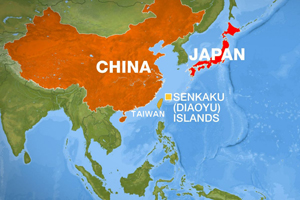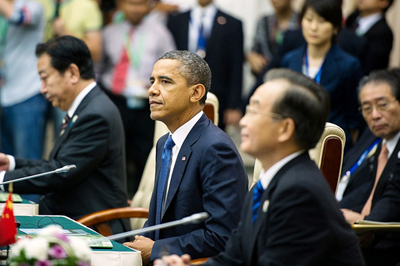Written by: Aiza Azam
Posted on: December 12, 2012 |  | 中文
| 中文
On September 11, 2012, it was announced that the Japanese government had completed purchase of three disputed islands in the resource rich East China Sea, which were claimed to hitherto have been under private Japanese ownership. The Diaoyu, Nanxiao and Beixiao islands (known as the Senkaku islands in Japan), form part of a chain of eight uninhabited islands that lie over a stretch of 7sq km, east of the Chinese mainland and southwest of Okinawa.
 The announcement triggered a strong, immediate, and uniform response from the Chinese government and public. A wave of protests broke out in several Chinese cities as citizens denounced Japan’s decision as illegal, calling for respecting China’s sovereignty over the disputed territory. Visits by Chinese nationals to Japan were cancelled; international seminars and conferences were snubbed; several activities organized to commemorate four decades of the normalization of bilateral diplomatic relations were called off; Japanese articles destined for export to China were boycotted. China’s State Council Information Office issued a white paper titled ‘Diaoyu Dao, an Inherent Territory of China,’ which cited historical and jurisprudential facts that support China’s claim, declared the Japanese claim to be unfounded and in violation of history and international law, and emphatically reiterated China’s resolve to safeguard its territorial integrity and its sovereignty over the islands. In parallel, the government undertook completion of international legal formalities with reference to the announcement of baselines of the territorial waters around the islands.
The announcement triggered a strong, immediate, and uniform response from the Chinese government and public. A wave of protests broke out in several Chinese cities as citizens denounced Japan’s decision as illegal, calling for respecting China’s sovereignty over the disputed territory. Visits by Chinese nationals to Japan were cancelled; international seminars and conferences were snubbed; several activities organized to commemorate four decades of the normalization of bilateral diplomatic relations were called off; Japanese articles destined for export to China were boycotted. China’s State Council Information Office issued a white paper titled ‘Diaoyu Dao, an Inherent Territory of China,’ which cited historical and jurisprudential facts that support China’s claim, declared the Japanese claim to be unfounded and in violation of history and international law, and emphatically reiterated China’s resolve to safeguard its territorial integrity and its sovereignty over the islands. In parallel, the government undertook completion of international legal formalities with reference to the announcement of baselines of the territorial waters around the islands.
The Japanese government issued a response rejecting the geological, geographic and historical evidence China had cited, as invalid grounds under international law. It reiterated the Government of Japan’s Cabinet Decision of 14th January, 1895, which announced the formal incorporation of the islands into Japanese territory, and emphasized that the decision had been taken after ten years of surveys and examination of the islands confirmed that they were completely uninhabited and showed no traces of having been under the control of the Qing dynasty of China. It also asserted that China had not declared a claim on the islands until the 1970s, when the question of developing potential petroleum resources off the continental shelf of the East China Sea came to the fore.
 |
| Chinese citizens in protest |
The conflict threatened to heat up further in the following weeks. China sent maritime surveillance vessels into the waters near the islands, risking altercations with the Japanese coast guard that patrols the area. In mid-October, the Japanese navy marked its 60th anniversary with a major display of Japanese maritime strength. 40 or so ships – including destroyers, hovercraft designed to facilitate amphibious landings, and conventionally powered submarines - and 30 aircraft participated in a massive naval exercise held in the waters south of Tokyo. They were joined by warships from the United States, Australia and Singapore. This was followed by a Chinese naval exercise held later the same week in the East China Sea, 11 sea vessels and 8 aircraft large. Chinese state news agency Xinhua reported that the exercises, in which the navy and civilian maritime agencies participated, were aimed at “sharpening their response to emergencies in order to safeguard China’s territorial sovereignty and maritime interests.”
A review of the history of the dispute reveals a complexity of events. After China’s defeat in the Sino-Japanese War of 1895, the two countries signed the Treaty of Shimonoseki, or the Treaty of Maguan, as it is known in China. According to the terms of the treaty, China was made to cede control of all islands that formed part of its territory to Japan, including the “island of Formosa, together with all islands appertaining or belonging to the said island of Formosa.” China contends that the Diaoyu islands fall under this latter category. However, Japan claims that these islands did not form part of the territory belonging to Formosa or even to any of the other islands China relinquished control of; hence Japan’s decision to incorporate the islands into its territory in 1895. These two opposing stances formed the basis for disagreement on sovereignty over the islands in all subsequent developments.
 |
| President Obama at the East Asia Summit |
In the Cairo Conference of 1943, China, the United Kingdom and the United States issued a communiqué, which declared that all territories that had been ceded by China to Japan, including Formosa, would be restored to China; this declaration was reiterated by the Potsdam Declaration of 1945. In the 1951 Treaty of Peace that Japan concluded with the Allies, also known as the Treaty of San Francisco, Japan renounced claim to a number of territories, including Formosa. Under the same treaty, parts of Japanese territory were placed under U.S .Trusteeship. On the day this treaty entered into force, on 28th April 1952, Japan concluded a separate Treaty of Peace with China, which entered into force on 5th August the same year; it recognized Japan’s renunciation of the cited territories under the peace treaty of the previous year. In 1953, the American Civil Administration responsible for the territory under U.S. trusteeship expanded its jurisdiction beyond the original boundaries to encompass the Diaoyu and affiliated islands, a measure which China never recognized. The Okinawa Reversion Agreement of 1971 restored all territory under U.S. control to Japan.
In essence, the Chinese stance holds that the Diaoyu islands were included in the territory that Japan returned to it as stipulated in the Treaties of Peace of 1951 and 1952, were not included in the region that went under U.S. Trusteeship and was later reverted, and, as far as China is concerned, there is no question as to its complete territorial sovereignty over the islands. To the contrary, Japan contends that the islands had never been part of Chinese territory, were uninhabited and unclaimed when brought under Japanese sovereign rule in 1895, had continued to exist in that state when they went under U.S Trusteeship and, subsequently, were returned to Japan in 1971.
For some decades, the two countries had kept the dispute on the back burner by mutual agreement, in the larger interest of the normalization of Sino-Japanese relations, beginning in the early 1970s, so that although small altercations caused the issue to crop up occasionally, it played a minor role in overall bilateral ties. It is important that the disputed area is tremendously rich in natural resources. The undeveloped sea-bed surrounding the islands contains 60-100 million barrels of oil and 1-2 trillion cubic feet of natural gas, both in proven and unproven reserves, in addition to rich fishing grounds.
Since the dispute erupted, the United States has been urging for a peaceful settlement of the issue and cautioning against allowing matters to escalate, as regional security and stability lies in the docket. It has also raised the matter at regional forums (such as the recent East Asia Summit), calling for a multilateral solution. The U.S. is tied into the dispute as its mutual defense treaty with Japan obliges it to defend the latter in the event of an armed attack. The American government has reiterated time and again that it will not take sides in the dispute. However, a recent announcement from Washington, on its intention to review its defense cooperation guidelines with Japan in the following months, is being viewed by many as a tacit indication of which side of the fence the U.S. is liable to choose.
The dispute is unlikely to escalate into an armed conflict, for several reasons: the potential threat it holds for regional stability and security, domestic political and economic considerations, and the economic interdependence of the states party to the dispute, are all factors that preclude armed conflict as an option. Should hostilities break out, they will have far reaching political, strategic and economic ramifications, within as well as beyond the region:
These factors and the Diaoyu dispute must be viewed against the backdrop of the U.S. pivot towards the Asia Pacific region. In a November 2011 article in Foreign Policy, U.S. Secretary of State Hillary Clinton wrote that a key task of American policy over the coming ten years would be to “lock in a substantially increased investment -- diplomatic, economic, strategic, and otherwise -- in the Asia-Pacific region.” The Pacific has begun to witness a U.S. military buildup. Even as the Pentagon issues statements negating perceptions of its containment strategy of China, the American administration is revitalizing its military alliances with Australia, South Korea, Japan, Thailand and the Philippines, and exploring the expansion of similar relationships with other nations such as, India, Vietnam and New Zealand. For some, these developments are beginning to feel reminiscent of the alliances and conflicts that defined the Cold War. The increasing U.S. footprint in Asia-Pacific and the response this continues to generate on part of certain regional countries leaves very little room for doubt as to American intentions.
The dispute and the resultant freeze in bilateral relations has also impacted Japan’s economic growth. Its economy shrank during the third quarter of 2012, and economic experts projected that the trend would continue. Bilateral trade between China and Japan lies at over $340 billion, and the sustained Chinese boycott of the latter’s exports has significantly affected the Japanese economy.
How the issue will play out and resolve itself remains to be seen, as China and Japan find themselves unable to come to even a temporary solution that is mutually acceptable. Neither country is willing to concede on what both assert is a matter of territorial integrity, and therefore not subject to compromise.
You may also like: